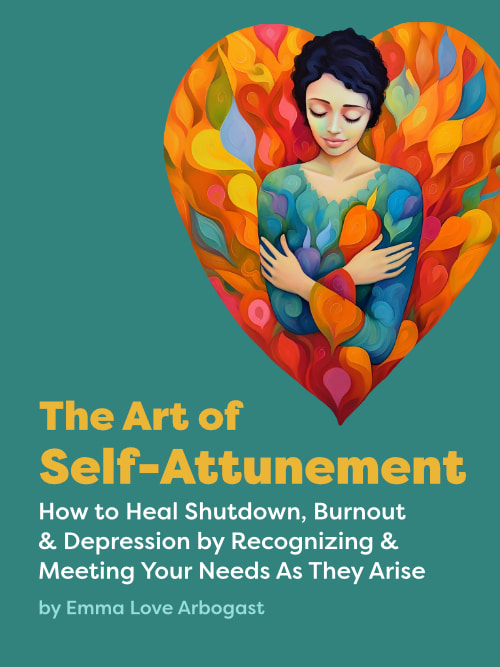Gentle Self-Discipline for People Who Resist Force
Self-discipline is tricky. Especially if you are someone with a high need for autonomy.
In the movies, there is always a big motivating factor, and then a montage of activity toward a goal, and finally a triumphant success.
In real life, it rarely works that way. We get the initial burst of energy. We make a plan. We do it faithfully for a few days. And then our old habits and patterns emerge and we are back where we started, only worse because we feel bad for not following through.
So what is required to make conscious progress toward a goal?
Self-Discipline vs Internal Alignment
Intrinsic motivation describes something you want to do for its own sake.
Extrinsic motivation describes something you do to make others happy, or to get a reward that is not directly related to the activity.
Intrinsic motivation is a much stronger motivator, and an essential component of self-discipline. The problem is that extrinsic motivation can supersede intrinsic and we can lose our sense of why we are doing something. When the goal is hard and requires discipline to achieve, this can destroy our motivation.
Many inner conflicts about self-discipline boil down to a conflict between intrinsic and extrinsic motivations.
Take losing weight, for example.
- Your intrinsic motivation could be to look and feel better, to enjoy more fashion options, and to live a longer and healthier life.
- But the extrinsic motivation to lose weight and be thin no matter what is a huge unspoken pressure that many of us feel every day.
When outside culture is handing us extrinsic motivation reminders daily (“you’ll be sexier! people will like you more!”) it can be hard to remember your own reasons and not feel like a tool for buckling to pressure by wanting to lose weight.
Here’s another example: I have struggled to change a habit of going to bed really late and waking up when half the day is over.
There is definite external pressure to not do this, because I don’t feel “normal”. I start judging myself, like I can’t get my life together. But these kind of messages are not motivating at all.
It’s actually de-motivating to criticize myself or hold out threats (“You’ll never have a normal life if you don’t get this together!”). Instead, I need to focus on my own internal reasons to want to get up earlier—for example, I feel better and am more productive when I have a regular bedtime.
Either way, I get to feel like I’m more a part of the society I live in if I share the same hours as most of the population. But to be motivating, I need to connect to that as a positive internal desire to be involved in life, not a negative judgement that there’s something wrong with me if I don’t change.
The workhorse of intrinsic motivation is inspiration—a compelling vision of a positive replacement for the current pattern.
I was recently talking with a friend about quitting smoking years ago. She had berated herself for years, and tried to quit a dozen times. But it wasn’t until one summer where she was a counselor at Girl Scout camp that she finally quit.
It was because she had something new to do that she loved: play with kids, outside. This was fun. It wasn’t about adding more force to quit, it was about finding something even better that made her feel alive.
Necessary Ingredient #2: Self-Trust
Self-discipline involves nudging yourself out of your normal way of being, to establish a new groove.
This is difficult—our brain is habit-forming by nature and always resists attempts to change.
Self-trust means the parts of you that need autonomy or comfort know that you are not going to push yourself too hard or too fast, and that you will pay attention to your real needs in the moment and accommodate them.
For example, my first goal with getting up earlier was to set my alarm for 10 am every morning. The first few days I was really tired all day and that makes me unhappy after awhile. So I checked in with myself and considered changing my goal to 11 am instead.
After a few days it turned out I adjusted to 10 am so I kept it, but knowing that I wasn’t going to consider myself a failure if I needed to adjust to an easier goal made me feel good and happy about the project. It creates an internal culture of positivity instead of forcefulness or fear.
Think of training a horse or taming a wild animal. You can’t just force the horse to do what you want it to do. You have to gain its trust and go slowly. It wants to learn, but it needs gentleness and trust. A lot of our brain is not much more sophisticated than that—we are still mostly mammal.
Can you relate?
I would love to hear your experience with this. What has helped you establish new patterns? What is your experience with intrinsic motivation vs extrinsic?
Self-love is a set of skills you can learn

Stop Being Cruel to Yourself
$2.99


Hey there! If you're new here, welcome to the Emmaverse! 🌈✨
About me: I'm autistic/ADHD and I write about how to be free and happy from the inside out.
Keep in touch?
Self-Liberation Society


No so much about this post but looking at your worksheets reminded me about a book I found very helpful:
http://www.amazon.com/Mind-Over-Mood-Change-Changing/dp/0898621283
Short and sweet article! It explains a lot to me about why i’ve been trying and failing over and over again for years. I was using extrinsic motivation, trying to survive on the initial jolt of motivation alone (and burning out fast), and getting out of my depth, pushing myself too hard, setting my goals too high then feeling like a loser when I inevitably ran out of gas.
This article is good, it’s up to the reader wether they apply the advice or not.
Cheers 🙂